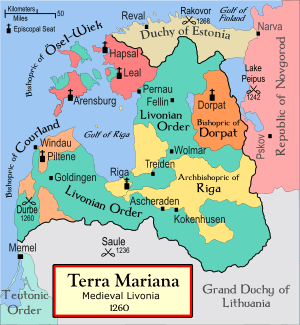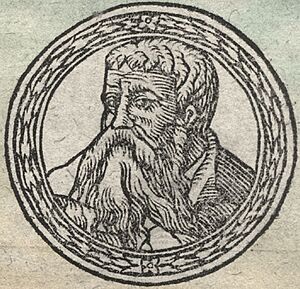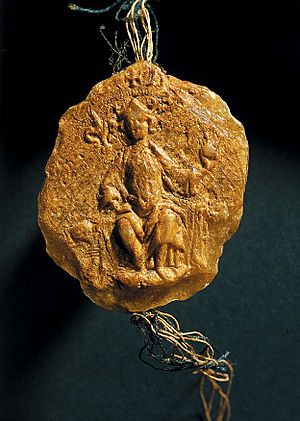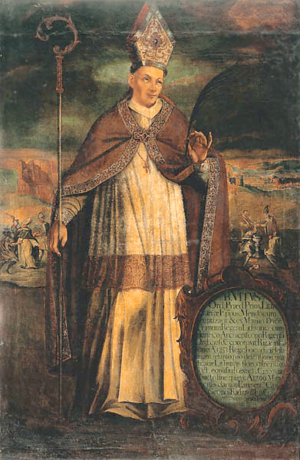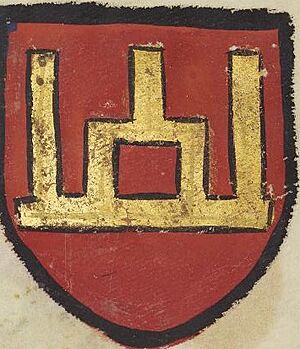History of Lithuania (1219–1295) facts for kids
The history of Lithuania between 1219 and 1295 is about the start of the first Lithuanian state. This state was called the Grand Duchy of Lithuania. Before this time, we don't have many written records. But from 1219, we learn about Lithuania from old writings and agreements.
In 1219, many Lithuanian leaders, called dukes, signed a peace treaty. This showed that the Baltic tribes were starting to come together. Even though they fought a lot with two Christian groups, the Livonian Order and the Teutonic Knights, the Grand Duchy of Lithuania grew strong. It took control of lands like Black Ruthenia, Polatsk, and Minsk. These areas were weak after the fall of Kievan Rus'.
Mindaugas was the first ruler to be called Grand Duke. Many people see him as the founder of Lithuania. He brought the Baltic tribes together and created the Duchy. Mindaugas was baptized in 1251 and became King of Lithuania in 1253. But in 1261, he stopped being peaceful with the Livonian Order. He might have even stopped being Christian. In 1263, Treniota killed him. This ended the first Christian kingdom in Lithuania. For over 100 years, Lithuania stayed a pagan empire. It kept fighting the Teutonic and Livonian Orders, who wanted to make the land Christian.
After Mindaugas died, Lithuania had a tough time. Seven different Grand Dukes ruled in 32 years. We don't know much about this period. But around 1280, the Gediminid dynasty began. Even with all the changes, the Grand Duchy stayed together. In 1295, Vytenis became ruler. For the next 20 years, he built a strong base for the Duchy to grow. Later, Gediminas and his son Algirdas led Lithuania to become even bigger.
Contents
How the State Began
Baltic Tribes Unite
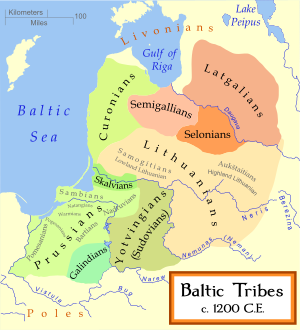
The Baltic tribes mostly united because of outside threats. Strong German religious groups were attacking them. In 1202, the Livonian Brothers of the Sword were formed. Their goal was to make the people near the Gulf of Riga Christian and conquer their lands. This group won many battles and became a big danger to Lithuania.
However, the Livonian Order was badly beaten in the Battle of Saule in 1236. After this, it almost fell apart. The next year, it joined with the Teutonic Knights.
In 1226, Konrad I of Masovia asked the Teutonic Knights for help. He wanted them to protect his borders and conquer the Prussians. He gave them land in Chełmno to use as a base. By 1230, the Knights built a castle there. They started attacking Prussian lands. After 44 years, they had conquered most of the Prussian tribes. Then, they spent nine years conquering other tribes like the Nadruvians and Yotvingians. By 1283, they were a bigger threat to the young Lithuanian state from the west.
The Lithuanian tribes also united because of changes within their society. People started owning land privately. This later led to a feudal system. In this system, only the oldest son could inherit land. This helped dukes keep their lands together. Different social groups also began to form. There were skilled soldiers (nobles), free farmers, and other workers. To keep this new society in order, a united state was needed.
Another reason for unity was the chance to take over lands in Ruthenia. These lands were weak after the Mongol invasion. Lithuanian dukes often teamed up for raids and to take riches from these lands. For example, they plundered Pskov in 1213. Between 1201 and 1236, Lithuanians raided Livonia at least 22 times. They also raided Rus 14 times and Poland 4 times. But to control these conquered lands, a strong central power was needed.
The Galicia–Volhynia Treaty
There is proof that Lithuanians started joining forces in the early 1200s. For example, in 1207, soldiers from all over Lithuania were gathered to fight the German religious groups. In 1212, Daugirutis made a treaty with Novgorod. This showed he had power over a large area. Some historians think a Lithuanian state might have existed as early as 1183.
But the clearest sign that the Baltic tribes were uniting is the treaty with Galicia–Volhynia in 1219. Twenty-one Lithuanian dukes signed this treaty. Five of them were called "elder" dukes, meaning they were more important. Živinbudas was likely the oldest duke, as his name was first. Mindaugas and his brother Dausprungas were also listed as elder dukes, even though Mindaugas was young. This suggests they inherited their titles.
This treaty is very important. It shows that Lithuanian dukes were working together. Dukes from far-off lands like Samogitia signed it, even though they probably didn't have much contact with Galicia–Volhynia. Their signing meant they felt they had common goals. This was a sign of a new state forming. However, having 21 dukes, with five "elder" ones, shows that the process of uniting was still ongoing. The different lands in Lithuania were still quite powerful and independent. Historians see this treaty as a key document in the long process of Lithuania becoming a state.
Mindaugas Rises to Power
Mindaugas, a duke from southern Lithuania, became the founder of the state. In 1236, the Livonian Rhymed Chronicle called him the ruler of all Lithuania. We don't know exactly how he gained this power. Old Russian writings say he killed or drove out other dukes, including some of his own relatives.
In 1236, Duke Vykintas led the Samogitian forces to a big win in the Battle of Saule. The Livonian Order suffered a huge defeat. It seems Mindaugas did not help Vykintas in this battle. Vykintas' power grew. The Livonian Order was almost destroyed and had to join the Teutonic Knights. These two strong groups then focused on conquering Samogitia. This land was the only thing stopping them from connecting their territories. The joining of these powerful enemies likely pushed the Lithuanians to unite even more.
Around 1239, Mindaugas took over the weakened Black Ruthenia. He put his son, Vaišvilkas, in charge there. In the early 1240s, Mindaugas made his power stronger in different Baltic lands. In 1245, Mindaugas sent his nephews, Tautvilas and Edivydas, to conquer Smolensk. But they failed. In 1249, a war started within Lithuania. Mindaugas wanted to take his nephews' and Vykintas' lands.
Tautvilas, Edivydas, and Vykintas formed a strong group against Mindaugas. They teamed up with the Samogitians, the Livonian Order, and Daniel of Galicia. Daniel was Tautvilas and Edivydas' brother-in-law. Only the Poles, invited by Daniel, refused to join the fight against the Lithuanians. The dukes of Galicia and Volhynia managed to take control of Black Ruthenia. This was an area ruled by Mindaugas' son, Vaišvilkas. Tautvilas went to Riga and was baptized there. In 1250, the Order launched two big attacks. One was against Nalša land, and the other was against Mindaugas' lands and parts of Samogitia that still supported him.
Mindaugas was in a very difficult spot, attacked from north and south. But he used the arguments between the Livonian Order and the Archbishop of Riga to his advantage. He bribed Andreas von Stierland, the master of the Order. Andreas was still angry at Vykintas for the 1236 defeat. In 1251, Mindaugas agreed to be baptized. He also agreed to give up some lands in western Lithuania. In return, he would receive a crown.
In 1252, Tautvilas and his allies attacked Mindaugas in Voruta. Some people think Voruta was the first capital of Lithuania. The attack failed. Tautvilas' forces went back to defend themselves in Tverai Castle. Vykintas died around 1253. Tautvilas then had to rejoin Daniel of Galicia. Daniel and Mindaugas made peace in 1254. The Black Ruthenian lands were given to Roman, Daniel's son. Vaišvilkas, Mindaugas' son, decided to become a monk. Tautvilas accepted Mindaugas' power and received Polatsk as his own land.
The Kingdom of Lithuania
As promised, Mindaugas and his wife Morta were crowned in the summer of 1253. The Kingdom of Lithuania, which the pope had announced in 1251, was now truly set up. July 6 is now celebrated as "Statehood Day" in modern Lithuania. It is a national holiday. However, the exact date of the crowning is not fully known.
Pope Innocent IV supported Mindaugas. He hoped that a new Christian state could stop the Golden Horde, a part of the Mongol Empire. On July 17, 1251, the pope signed two important documents called papal bulls. One ordered the Bishop of Chełmno to crown Mindaugas as King of Lithuania. It also told him to appoint a bishop for Lithuania and build a cathedral. The other bull said that the new bishop would report directly to the pope. This was good news for Lithuanians. They worried that the Livonian Order, their old enemies, would have too much control over their new state.
It took some time to appoint a Bishop of Lithuania because of different groups wanting control. The Bishop of Gniezno appointed Vito, a monk, to this job. But Mindaugas did not accept him, and the people did not like him. We don't know what Vito did in Lithuania. Finally, in 1254, Christian from the Livonian Order was appointed. Mindaugas gave him some lands in Samogitia. But we don't know much about what he did. There are no records of missionaries, priest training, or church building during that time. Bishop Christian went back to Germany in 1259.
The building of Mindaugas' Cathedral is still a mystery. But recent digs found parts of a 13th-century brick building where the Vilnius Cathedral is now. People generally think these are the remains of Mindaugas Cathedral. It was likely built to keep the agreement with the pope. However, Lithuanians later resisted becoming Christian. Mindaugas' baptism only had a short-term effect.
Right after his crowning, Mindaugas gave some western lands to the Livonian Order. These included parts of Samogitia, Nadruva, and Dainava. There is some debate about whether Mindaugas gave even more lands later (1255, 1257, 1259, 1261). The documents might have been faked by the Order. Some documents mention lands that Mindaugas did not even control.
Anyway, there was peace and stability for about eight years. Mindaugas used this time to expand his power to the east. He became stronger in Black Ruthenia and Pinsk. He also took advantage of the fallen Kievan Rus' by conquering Polatsk. This was a big trading center on the Daugava River. He also made peace with Galicia–Volhynia. He married his daughter to Svarn, Daniel of Galicia's son. Svarn later became Grand Duke of Lithuania. Mindaugas also improved relations with western Europe and the Pope. In 1255, Pope Alexander IV allowed Mindaugas to crown his son as King of Lithuania.
At home, Mindaugas worked to set up state systems. He created his own noble court, ways to manage the state, and a system for talking with other countries. He also started a money system. Silver coins called "Lietuvos ilgieji" were used. This showed that Lithuania was a real state.
The Livonian Order used this time to make their control over Samogitian lands stronger. They built three castles along the border. The Samogitians fought back. They chose Algminas as their war leader and attacked Courland. The Order had limited success in battles. In 1259, the Livonian Order lost the Battle of Skuodas. In 1260, they lost the Battle of Durbe. The first loss led to a rebellion by the Semigalians. The second loss made the Prussians rise up against the Order. The Great Prussian Uprising lasted for 14 years.
Mindaugas' nephew, Treniota, encouraged him. Mindaugas then broke the peace with the Order. Some old writings suggest he went back to his old pagan beliefs. But this is not certain. Still, all the good relations he built since his crowning were lost.
Mindaugas then teamed up with Alexander Nevsky of Novgorod. They marched against the Order. Treniota led an army to Cēsis and fought Masovia. He hoped to make all the conquered Baltic tribes rise up against the Orders. He wanted them to unite under Lithuanian leadership. He won battles but could not capture the strong castles. He also failed to create a big group of Baltic forces against the Order.
Treniota's personal power grew. Mindaugas was busy conquering lands in Rus'. He sent a large army to Bryansk. Treniota and Mindaugas started to have different goals. During these events, Mindaugas' wife Morta died. Mindaugas then wanted to marry Daumantas' wife. Daumantas and Treniota were insulted by this. They killed Mindaugas and two of his sons in 1263.
After Mindaugas' Reign
Years of Instability

After Mindaugas' death, the state did not fall apart. Treniota became Grand Duke. But his power was weak. Tautvilas, who still wanted power, challenged him. Treniota also killed Tautvilas. However, just one year later, in 1264, Mindaugas' former servants killed Treniota.
Mindaugas' son Vaišvilkas and his brother-in-law Švarnas from Volhynia then took control of Lithuania. Daumantas had to run away to Pskov. He was baptized Timofei and ruled Pskov well from 1266 to 1299. He even became a saint. In 1265, Vaišvilkas, being Christian, made peace with the Livonian Order. Without support from Lithuania, the rebellions among the Balts, which Treniota had started, began to die down.
We don't know much about Švarnas and his rule. But historians believe he could not control all of Lithuania. He probably only ruled the southern parts.
Traidenis' Rule
We are not sure how the next ruler, Traidenis, came to power in 1269. From the start, his relations with Galicia–Volhynia were difficult. This led to a war from 1274 to 1276. Traidenis won battles and made his control over Black Ruthenia stronger.
Traidenis was known for being strongly against the Germans. He also fought successfully against the Livonian Order. In 1270, he won the Battle of Karuse, fought on ice. But in 1272, the Order fought back. They attacked Semigalia and built Dünaburg Castle in 1273. This was on lands that Traidenis supposedly controlled. Several years later, in 1281, Traidenis conquered Jersika Castle. He was able to trade it for Dünaburg Castle. Dünaburg stayed a Lithuanian outpost until 1313.
In 1279, the Order attacked Lithuanian lands, reaching as far as Kernavė. But on their way back, they lost a major battle in the Battle of Aizkraukle. The Order's master died in the battle. The conquered Semigallians then rebelled. The Semigallians were willing to accept Lithuania's power and asked Traidenis for help.
Traidenis' rule was the longest and most stable during this time of trouble. After he died, the Orders finished their conquests. The conquered Baltic tribes did not rebel again. The Orders could now focus on Lithuania. In 1274, the Great Prussian Rebellion ended. The Teutonic Knights then conquered other Baltic tribes. By 1283, the Livonian Order finished conquering Semigalia. This was Lithuania's last Baltic ally.
The Gediminids Rise
We are not very sure about who the Grand Dukes of Lithuania were between Traidenis' death in 1282 and Vytenis becoming ruler in 1295. This is because the two main sources for Lithuanian history from this time end in the early 1290s. In 1285, one writing mentions Daumantas as Grand Duke. He attacked the Bishop of Tver and was badly hurt or even killed in the battle.
The Gediminid family began to rise in Lithuania during this time. Their first leader was Butigeidis. In 1289, he led about 8,000 soldiers and attacked Sambia. In 1289, the Teutonic Knights built a castle in Sovetsk. Their raids became more frequent. Butigeidis was the first to build strong castles along the Neman River. He died in 1290 or 1292. His brother Butvydas (also called Pukuveras) became the next ruler. Butvydas was the father of Vytenis and probably of Gediminas. During his short rule, Butvydas tried to protect the Duchy from the Teutonic Knights. He also attacked Masovia, an ally of the Knights.
Legacy of Early Lithuania
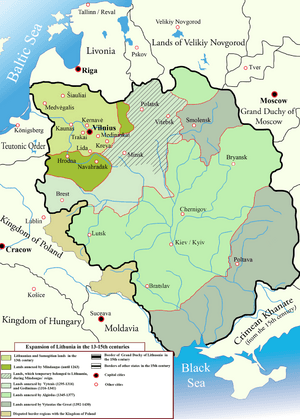
The state that Mindaugas united and ruled was the first Lithuanian state. This state protected Lithuanians and Samogitians from being taken over by the Teutonic Knights and the Livonian Order. Other Baltic tribes, like the Prussians and Curonians, were not as lucky.
Mindaugas ruled about 100,000 square kilometers of Lithuanian land. About 300,000 people lived there. The Slavic lands he controlled or influenced covered another 100,000 square kilometers. By around 1430, at its largest under Vytautas the Great, the Grand Duchy controlled about 930,000 square kilometers. It had almost 2.5 million people.
The period from 1219 to 1295 also set up future conflicts. The pagan Lithuanians were surrounded by the strong Roman Catholic Orders to their north and southwest. To the east, they faced followers of the Orthodox Church. The Catholic Orders' attacks became stronger after they conquered the "buffer zone" of other Baltic tribes by 1283.
Lithuania's relations with the Orthodox Church were more peaceful. People were allowed to practice their religion. Lithuanian dukes often married daughters of Orthodox dukes. Some of the dukes' writers were probably Orthodox too. Fighting the Teutonic Knights and expanding to the east were common from 1295 to 1377. Lithuania could not stay religiously, politically, and culturally isolated forever. It would have to choose between Roman Catholicism or Eastern Orthodoxy. In 1386, Grand Duke Jogaila chose to be baptized as a Catholic. He married Jadwiga of Poland and became King of Poland. This was how the last pagan state in Europe became Christian.
See also
 In Spanish: Historia de Lituania (1219-1295) para niños
In Spanish: Historia de Lituania (1219-1295) para niños


